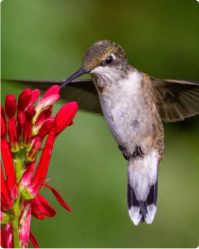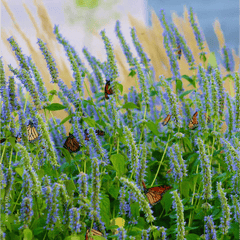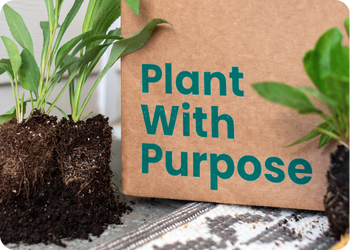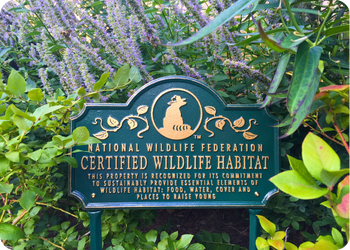Guide to Milkweed Plants and Monarch Butterflies

It’s not a weed, and it doesn’t produce milk, but the humble milkweed is one of the most important plants you can have in your garden. Despite its misleading name, the milkweed is a tough native plant that grows just as well in North American wetlands as it does in fields and prairies.
The reason why milkweed is so important comes down to the dwindling number of monarch butterflies. While most butterfly species can feed on a variety of host plants, monarch caterpillars can only survive on a diet of milkweed. That’s why monarch butterflies are often referred to as milkweed butterflies!
As monarch butterflies continue to suffer from dwindling numbers, gardeners are doing what they can to restore their populations. Monarch butterflies have a special place in the North American psyche, so it’s no surprise to find that Monarch Munchable plants are more popular than ever. While milkweed is perfect for monarch butterflies, the fact is that wild milkweed is rapidly vanishing from fields and gardens due to threats including a loss of space and the widespread use of weedkillers.
If we are to help restore the rapidly declining population of monarch butterflies, planting native milkweed will be critical. Here’s everything you need to know about milkweed plants.
Milkweed plants — quick facts
The flowers on milkweed are ideal for easy pollination. Their small, star shapes make it easy for butterflies and other pollinators to access the pollen they need, and the flowers come in dramatic blooming colors like purple, pink, green, yellow, and orange. When the flowers are fertilized, they produce seed pods that can release hundreds of milkweed seeds.
You can expect milkweed plants to grow between 2-5 feet, although this will depend on the species of milkweed you have. Whichever you opt for (considering the best native plant for your state), you won’t just be attracting monarch caterpillars. Milkweed is also great to have in your garden if you want to attract native bees, a wide array of butterfly species, and even hummingbirds!
Milkweed plants — a must-have for monarchs
Monarch butterflies use milkweed as both a food source and a place to lay their eggs. Monarchs lay their eggs on the underside of the milkweed leaves, and the hatching larvae feed on those leaves. However, despite eating the plant it’s born on, those young caterpillars don’t cause any permanent harm to the milkweed.
One of the most overlooked advantages of being so closely linked to the milkweed plant is that by eating the sap of milkweeds, butterflies and caterpillars become extremely unappetizing to a wide range of predators. Toxic chemicals within the milky sap are great for keeping threats at bay.
Why grow milkweed?
Populations of monarch butterflies are in decline. Why does that matter? Monarch butterflies are one of the most well-known and recognizable species of butterfly. Due to that recognizability, it’s easy to notice when their populations are in decline. So monarch butterflies are generally considered in the same way as a canary in a coal mine — their population drop is paralleled in other pollinating species.
According to the The International Union for Conservation of Nature (IUCN), the monarch butterfly population is now vulnerable. Between the 1980s and 2021, it is estimated that the western population of the monarch butterfly has dropped by around 99.9%. The bigger eastern population also shrunk by 84% from 1996 to 2014. Extinction is a very real threat.
The U.S. Fish and Wildlife Service (USFWS) is now proposing to list the monarch butterfly as a "threatened" species under the Endangered Species Act. According to its latest assessment, the USFWS puts western monarch population at greater than 99% chance of extinction by 2080.
Monarch butterflies are declining because native milkweed is declining. The combination of habitat loss and pesticide use has a clear negative impact, as pollinators like the monarch are an important part of our food web. For monarch butterflies to survive, milkweed plants need to become much more widespread, and monarch conservation needs to be a priority. Because if milkweed continues to vanish, so too will the beautiful monarch butterfly.
This is where home gardeners come in. Using home gardens, there are potentially millions of acres of usable habitat ideally suited to growing milkweed. That’s not even counting the estimated 40 million acres of land currently being used as nothing more than a lawn — that alone is three times more land than corn or any other kind of irrigated crop.
What is milkweed?
There are over 70 species native to the U.S., making it a vast genus. It’s the only plant that monarch caterpillars can feed on, so it’s of vital importance. Monarch butterflies evolved alongside milkweeds, so they are uniquely suited to feed on the plant while many other insects cannot.
That comes down to the latex sap that milkweed produces. Containing toxic compounds (cardenolides), the milkweed sap is toxic to many other insects if they try to eat it. So they avoid it. The sap also gets absorbed by monarch caterpillars and, in turn, the monarch butterfly, making them toxic to predators like birds too.
Choosing the right milkweed for your garden
Not every kind of milkweed plant will be suitable for your garden. One big mistake many home gardeners make is reading about the importance of milkweed and then planting common milkweed (Asclepias syriaca). This is a great native plant in many ways but can also be extremely aggressive. So for anyone with a small yard that wants a variety of native plants, common milkweed can be a mistake.
So you need to know what kind of milkweed is best suited to your state. You can do this easily using our native plant finder. However, the three milkweed plants you’ll find suitable for most garden sizes include the following:
Orange butterfly milkweed
The Asclepias tuberosa is one of our most popular native plants. It will grow to 1-3ft, with a spread of 1-1.15ft. It will bloom beautifully between June and September and thrives in dry and moist soil. The orange butterfly milkweed won’t just attract monarch butterflies either. Plant orange butterfly milkweed, and your garden will start to attract a variety of native bees, bumblebees, insects, and a wide range of butterflies.
Whorled milkweed
Asclepias verticillata will grow up to 3ft, with up to 2ft of spread, so it’s great for larger yards. It will bloom between May and September and thrives in both full sun and part shade spaces. However, if your soil is too moist, you may struggle to keep whorled milkweed healthy. Whorled milkweed grows healthily in sandy, clay, and rocky soil and is also deer resistant!
Swamp milkweed
One of the largest milkweeds, Asclepias incarnata, will grow up to 4ft high, with a spread of as much as 3ft. Blooming between June and October, swamp milkweed needs access to the sun, although it can also thrive even in part shade environments. Just as at home in both moist and wet soil, swamp milkweed loves a bit of clay-based soil too. The flowers are beautifully fragrant and will attract everything from bees and caterpillars to hummingbirds.
Diversify your milkweed but avoid tropical milkweed
Ideally, you don’t want just one species of native milkweed in your garden but you should always avoid tropical milkweed (Asclepias curassavica). This is incredibly easy to grow, but it comes with host parasites that will hurt monarch butterflies. Tropical milkweed can even disrupt the all-important migration of monarchs. Tropical milkweed is commonly found in big-box stores so you'll need to pay close attention to the specific type of milkweed whenever you make a purchase.
While female monarchs will lay their eggs on most milkweed species, they have their preferences. Swamp milkweed and common milkweed tend to attract the highest number of monarch eggs, while eggs laid on tall green milkweed or prairie milkweed are the least likely to survive.
So while there are preferences, there’s no single species of milkweed plant that you have to focus on — and that’s where a more diverse range of options comes in. If you’re planning to grow a wild garden filled with native plants, remember to plant different types of milkweed and other native species. Focusing on a single species limits how much you can support your local wildlife. We're rebuilding critical habitat to save wildlife, not just planting a single plant!
That’s why our Monarch Munchables Collection is so popular. It contains multiple species of state-native pollinator plants that make your yard much more diverse, exciting, and environmentally beneficial. Remember always to plant native plants that are best suited to your state — they’re going to be easier to look after and benefit the local biodiversity as well.
How to grow milkweed plants
The best thing about milkweed plants is that, like planting any native plants, they are tremendously easy to grow. If you're looking for the easiest possible growing, then it’s best to start with plants rather than seeds. All you have to do is plant those milkweeds into your garden during the spring, summer or fall (just need to wait for the threat of frost to go).
What’s important to remember is that not all milkweed varieties will thrive in your garden. It’s all going to depend on your location, the lighting (full shade, part shade, or full sun) and the humidity/dryness of the soil. That’s why it’s so important to do your research before you start buying milkweed plants. Our Plant Finder Quiz can help!
Growing milkweed from seed
Many people want to grow their milkweed plants from seed. What surprises many is that the best time to plant those seeds is in the winter! Yes, winter is the single best time of year to get those seeds into the ground. That's because perennial milkweeds require a period of freezing temperatures before they are able to break dormancy. This process is known as stratification.
In natural environments, milkweed seeds go through that stratification without interference. You need to replicate that experience as much as possible. That’s great news if you don’t want to spend a lot of time in the garden because it simply means you can:
1: Plant the milkweed seeds
Simply drop the milkweed seeds on top of the soil. You don't want to embed them into the soil because they need natural light to grow. Use your hand to press them gently into the earth, but don’t cover them. If you do cover them with your soil, they simply won’t grow.
2: Leave them alone
Plant your milkweed seeds over the winter and you won’t need to do anything else! They’ll be at the perfect temperature and receive the ideal amount of light. So as the spring arrives, they’ll be ready to germinate.
Remember that if you live in a colder climate, milkweeds might die off at the end of every summer, but they’ll be back next spring.
Where should I plant milkweed?
While there is a range of milkweed plants that require different conditions to thrive, there are some basics worth bearing in mind. When it comes to light, milkweeds of all varieties are remarkably hardy. They will grow their best in full sun locations (preferably with between 6-8 hours of sun every day). But they will be just as happy with part shade spaces too.
Soil types
This is where things can get a little more complicated. There are many types of milkweed, and they vary wildly in terms of the soil that suits them best. Here’s a small breakdown to give you an idea of what to look out for:
- Swamp milkweed (Asclepias incarnata)— Prefers moist environments
- Whorled milkweed (Asclepias verticillata) — Thrives in arid conditions
- Orange butterfly milkweed (Asclepias tuberosa) — Likes sandy soils, preferably dry
How much space between milkweed plants?
Ideally, you want to place most milkweed seeds about 18-inches apart. That’s because they have long, deep root systems. For something like swamp milkweed though, you need to aim for around 30-36-inches apart as they will tend to form clumps as they mature.
While monarch butterflies are very good at finding milkweed plants, every little helps, so the more plants you add, the better. Try to plant them out of the wind as that will make it much more comfortable for the butterflies they attract, including monarch butterflies.
As your milkweed plants begin to grow, you can start to thin them out if they are too close together, stopping them from competing for sunlight and nutrients from the soil.
How often does milkweed need watering?
If you just planted, continue to water daily for at least the first two weeks as your plant’s roots become established. If the weather is hot and dry, continue to water regularly. After that, most species of milkweed will have very average (or even less than average) watering requirements. Most naturally prefer drier conditions, so they will thrive even if you think you're underwatering them. Swamp milkweed is one of the outliers again though, as that species will always grow more healthy in either very moist areas or if you give them more water than you think is necessary.
One of the best ways to work out if you've watered your milkweed plants enough is to touch the top of the soil with your hands. If the top two inches of soil feels dry, it’s time to water. Don’t water again until those top two inches feel dry again.
Do I need to fertilize milkweed plants?
Like most native plants, growing native milkweed varieties means you won’t have to fertilize your soil. Even with relatively poor soil, milkweed takes very little to look after. Just scatter the seeds and wait for spring!
Aphids and milkweed plants
Milkweed is well-known for attracting aphids! You’ll find that milkweed aphids appear as small yellow specks on your plants, with tiny black legs, and they tend to gather together around the stem.
They can look very worrying, especially in high numbers. However, they aren’t doing your milkweeds any harm (unless the density is extremely high), and they won’t harm any monarch butterflies that visit either.
If you want to get rid of the aphids from your milkweed plants, try to remove them by hand. If that doesn’t do the job, then simply trim the most heavily affected stems. Alternatively, you can even spray the plants with your garden hose. Don't use pesticides or any kind of insecticide. They are just as likely to affect and kill the pollinators, such as monarch butterflies that are attracted to your pollinator garden.
Bringing monarch butterflies back with milkweed plants
The monarch butterfly is on the brink of extinction. The use of pesticides, excessive green space development, and climate change are all contributing to the steady decline of monarch butterfly populations. That’s all due to a lack of milkweed plants. Approximately 165 million acres of milkweed have vanished due to pesticides and agricultural practices.
We need to reverse that trend. We can only do so by actively restoring native milkweed and other pollinators to natural habitats and for gardeners to recognize the science behind wildlife habitat gardens.
Of course, it’s not just monarch butterflies that are at risk. Around two-thirds of native butterflies in the US are seeing a rapid population decline. So if you're looking at your garden and wondering what you can do to help, milkweed is undoubtedly something you should consider. Easy to plant, almost too easy to look after, and beneficial for a wide range of insects, birds, and animals, there’s simply no excuse not to have a few milkweed plants in your garden.
Check what native plants are best suited for your garden with our state plant finder. Simply choose your state, and we’ll let you know exactly what plants best suit your green space. Get it right, and your yard will become a thriving hub for local wildlife. You can also explore our best-selling native plant collections here.

Find Native Plants by Zip Code
We took the guesswork out of planting native. Check your zip to see what ships!
























